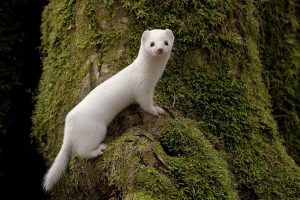| Project duration: | 2014-2017 |
|---|---|
| Project status: | Active |
| Project leader: | dr hab. Karol Zub |
Research project objectives
The main purpose of planned study is to investigate how variation of morphological traits (presence or absence of white winter pelage), physiological traits (metabolic rates, thermoregulation), behavioral traits (reaction to presence or absence of snow cover), and genetic variation associated with these traits, affect fitness of individuals representing different subspecies of weasel Mustela nivalis. In Poland two subspecies of weasels occur and they differ in presence (M. n. nivalis) or absence (M. n. vulgaris) of white pelage in winter. They may occur in the same area, e.g. in the Białowieża Forest, but proportion of each subspecies in the population varies among years and habitats. Weasels are small animals thus exceptionally vulnerable to predation and cryptic coat color may affect their mortality. Camouflage mismatch in seasonal coat color can be important factor of natural selection. The main hypothesis we would like to test says that if change of winter pelage color is an adaptive trait we should observe association between mortality (fitness measure) and genes (or alleles) determining winter whitening. Natural selection should favor one of the subspecies over another, according to prevailing weather conditions (ambient temperature, duration of snow cover). Alternative hypothesis says that natural selection is not targeting winter pelage color, but other traits associated with specific phenotype, e.g. resting metabolic rates (RMR), thermoregulation capacity (ability to dissipate heat in summer or to lower body temperature in winter) or behavior (change of activity period, avoidance of certain background color).
Project methodology
The study will be performed on molecular level (polymorphism and expression of genes codind melatonin receptos, and polymorphism of genes coding MC1 receptor), individual level (variation of resting metabolic rates – RMR and seasonal variation of body temperature) and population level (mortality rates of weasels belonging to different subspecies examined by extensive trapping of marked individuals and use of camera-traps). To estimate difference in predation level on two subspecies we are going to use mobile “models” of brown and white color, placed on different background (contrasting and matching the color of model). Next to the models camera-traps will be installed, which enable registration of all attacks of predators on models. Under controlled conditions (enclosures) we are going to perform behavioral observations, to determine reaction of individuals characterized by different winter pelage to color of background (change of time and duration of activity, usage of shelters)..
Scientific importance
Recently studies on adaptations of mammals to changing environmental conditions are becoming more important, mainly due to relatively fast climate changes. More and more examples demonstrate that variation range of phenotypic traits and underlying genetic variation is big enough to enable rapid adaptations to changing climatic conditions. On the other hand adaptational value of phenotypic traits and related genetic structure is poorly studied, especially in natural conditions. Our study make possible to tell how environmental conditions affect fitness of individuals characterized by certain phenotypic traits and what genes are responsible for variation of theses traits. Currently, association between phenotypic and genetic adaptations are in main focus of research on mechanisms of natural selection. Moreover, results of our study shed new light on current distribution of mammal species and enable to predict changes of their range.

